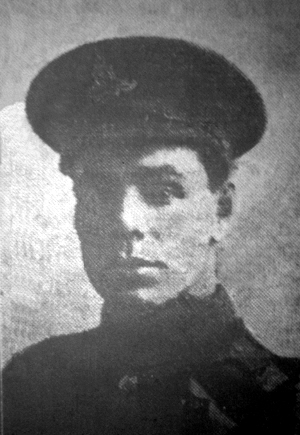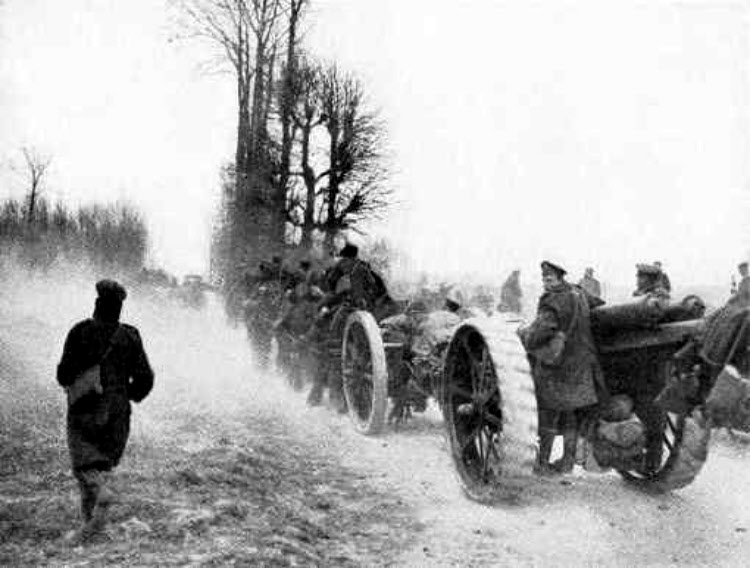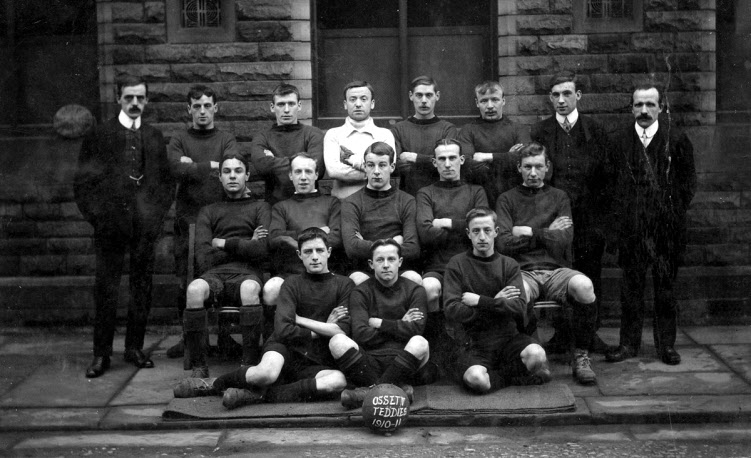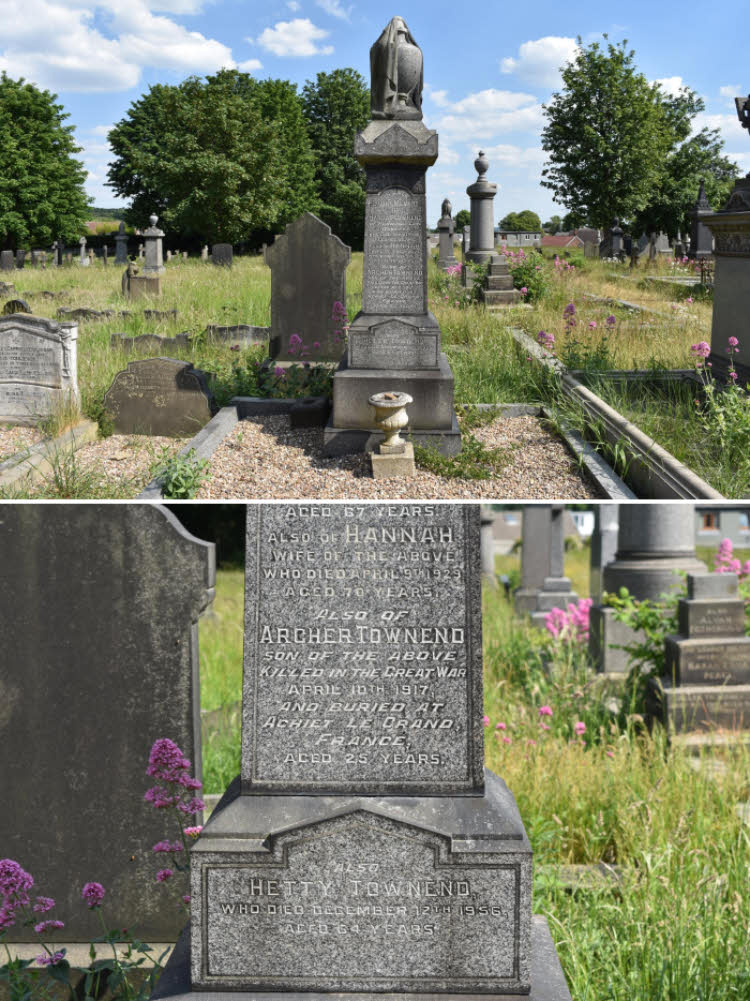
89040, Royal Garrison Artillery, 116th Heavy Battery
Archer Townend was born in Ossett in April 1891, the son of Harrap Townend and Hannah (nee Threadgold), who married in Dewsbury on 5th October 1878. Archer was one of eight children, five boys and three girls born between 1879 and 1905. Archer was the fifth born and youngest son.
In 1901 and 1911 Harrap Townend, a woollen rag salesman and his wife Hannah are living with seven of their eight children in the six-roomed, Runtlings House, Runtlings Lane, Ossett. Harrap and Hannah remained living there with their three unmarried daughters and one of their sons at least until April 1919. By this time three of Archer’s brothers had moved from the family home but all three remained living in Ossett at Moorcroft, Sunnybank Street and Springstone Avenue.
On 15th February 1915 the 23 year-old, rag merchant, Archer Townend married Hetty Morris at St. John the Baptist Church, Dewsbury. They had one child, Eli Morris Townend born on the 20th December 1916 at their home address of 24, West Wells Road, Ossett, where Hannah is recorded living in April 1919.
Private 89040, Archer Townend’s army service record has survived. Archer, then aged 24 years and 8 months, enlisted on the 9th December 1915 and was posted to the Army Reserve. He was mobilised on the 20th May 1916 and transferred to the Royal Garrison Artillery on the 5th June 1916. He was in training at Winchester (in the 175th Heavy Battery) on 18 July 1916 and he embarked at Southampton for Le Havre, France on the 30th September 1916. He was transferred from the 175th Heavy Battery and joined the 116th Heavy Battery in the field on the 4th October 1916.
Gunner Archer Townend was killed in action on the 10th April 1917. On the 13th August 1917 Archer’s effects were forwarded to his widow and comprised letters, photographs, cards, news cuttings and a wallet His widow, Hetty, was awarded a weekly pension of 18/9d for herself and her child from the 29 October 1917. Archer was awarded the British and Victory medals.
116th Heavy Battery, Royal Garrison Artillery (R.G.A) was formed at Woolwich on the 27th September 1914 from 100 Company, R.G.A. They moved to 23 Heavy Artillery Group on the 6th of February 1917 and then to 45 Heavy Artillery Group on the 26th May 1917. By November 1918 116th (Heavy) Battery, R.G.A. was serving with the 83rd (Mixed) Brigade, R.G.A, in the British Fourth Army. The 116th (Heavy) Battery, R.G.A. employed six 60 pounder guns.
The smallest artillery unit was the battery, consisting of six guns and roughly two hundred men. Horsed batteries had around 150 horses as well. Heavier guns were grouped in smaller batteries, as few as two for super-heavy rail guns, but manpower varied little. Batteries had no staff of their own, and field batteries only a maximum of five officers: a major as Battery Commander; a captain in charge of administration and transport; and three lieutenants each commanding two guns (a section), including their personnel and horses.
Archer Townend probably died at the Battle of Vimy Ridge from the 9th to 12th April 1917, in support of the Canadians tasked with taking the ridge. At dawn on the morning of Easter Monday 1917, the 9th of April 1917, the Canadian attack comprising four divisions began, following a heavy three-week British artillery barrage and was supported by a well-devised creeping barrage.
Within thirty minutes the Canadian 1st Division, under Arthur Currie, had succeeded in capturing German front line positions in spite of a snowstorm; within a further half hour the second line had similarly passed into Canadian hands. With the entire ridge wholly under Allied control by 12 April (when Hill 145, the highest feature on the ridge, fell) the operation was judged a spectacular success, the single most successful Allied advance on the Western Front to that date. The ridge remained in Allied hands for the remainder of the war.
It did not come without cost however: 10,602 Canadians were wounded during the attack, and 3,598 killed. The opposing German force suffered even more heavily: 20,000 casualties.

Above: Royal Garrison Artillery 60lb gun team like the unit that Archer Townend served with during WW1.
The “Ossett Observer” 1 had this obituary for Archer Townend:
“Ossett Artillery Driver’s Sad Death – Blown Up With His Horse – Another well-known Ossett man, Driver Archer Townend (25), of the Royal Garrison Artillery, youngest son of Mr. and Mrs. Harrap Townend, of Ivy Cottage, Runtlings-lane, Ossett, has made the supreme sacrifice. Before joining the colours in May last year the deceased was associated with his brother in the rag business, and a few years ago was a prominent member of the Ossett Temperance Football Club, being a reliable full-back.
Official news of his death was received at his home 24, West Wells-road, on Saturday. According to a letter from a comrade, Driver Townend, who was attached to an ammunition column, was blown up and killed, along with his horse, on Easter Sunday, April 10th, as ammunition was being conveyed to the battery. His comrade also spoke of helping to carry the deceased to his last resting place. Deceased leaves a widow and one child, the latter only a few months old. Two of deceased’s brothers, Harrap and Bernard, are serving, and Private Gerald Townend, of the R.A.M.C., killed recently, was a cousin.”

Above: Ossett Temperance Football Club, the ‘Ossett Teddies’ in 1910/11. Archer Townend is seated, middle-row, first on the left. There are possibly two other WW1 casualties on this picture. It is believed that the man seated centre in the middle row is Eli Townend Archer and standing, second from the right, on the back row is George Gawthorpe, who were both killed in action during WW1.

Above: The Townend grave at St. John’s Methodist Chapel showing the memorial to Archer Townend, son of Harrap Townend. Picture courtesy of Lisa Jennings.
Gunner Archer Townend died on the 10th April 1917 at the age of 25 years, the husband of Hetty Townend, of 24, West Wells Road, Ossett and is buried at grave reference IV. K. 7. at the Achiet-le-Grand Communal Cemetery Extension, 2 Achiet-le-Grand, Pas de Calais, France. Achiet-le-Grand is a village 19 Kms south of Arras.
Achiet-le-Grand was occupied by the 7th Bedfords on 17 March 1917, lost on 25 March 1918 after a defence by the 1st/6th Manchesters, and recaptured on 23 August 1918. From April 1917 to March 1918, the village was occupied by the 45th and 49th Casualty Clearing Stations. Achiet station was an allied railhead.
The communal cemetery and extension were used by Commonwealth medical units from April 1917 to March 1918. The extension was also used by the Germans to a small extent in March and April 1918, and again by Commonwealth troops in August 1918. After the Armistice Plot III and most of Plot IV were made when 645 graves, mainly of 1916 and March and August 1918, were brought in from the battlefields around Achiet.
The extension contains 1,424 Commonwealth burials and commemorations of the First World War. 200 of the burials are unidentified but there are special memorials to eight casualties known or believed to be buried among them. Other special memorials record the names of ten casualties buried in other cemeteries whose graves could not be found. There are also 42 German war graves in the extension.
References:
1. “Ossett Observer”, 5th May 1917